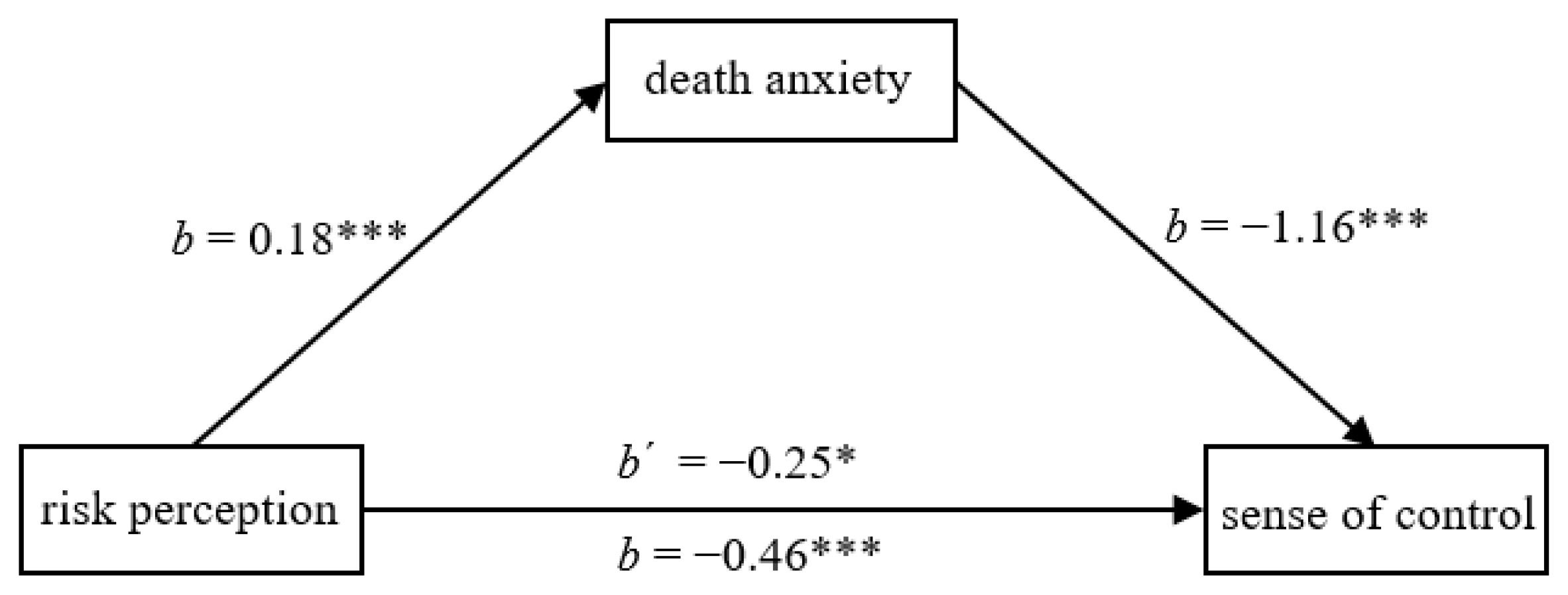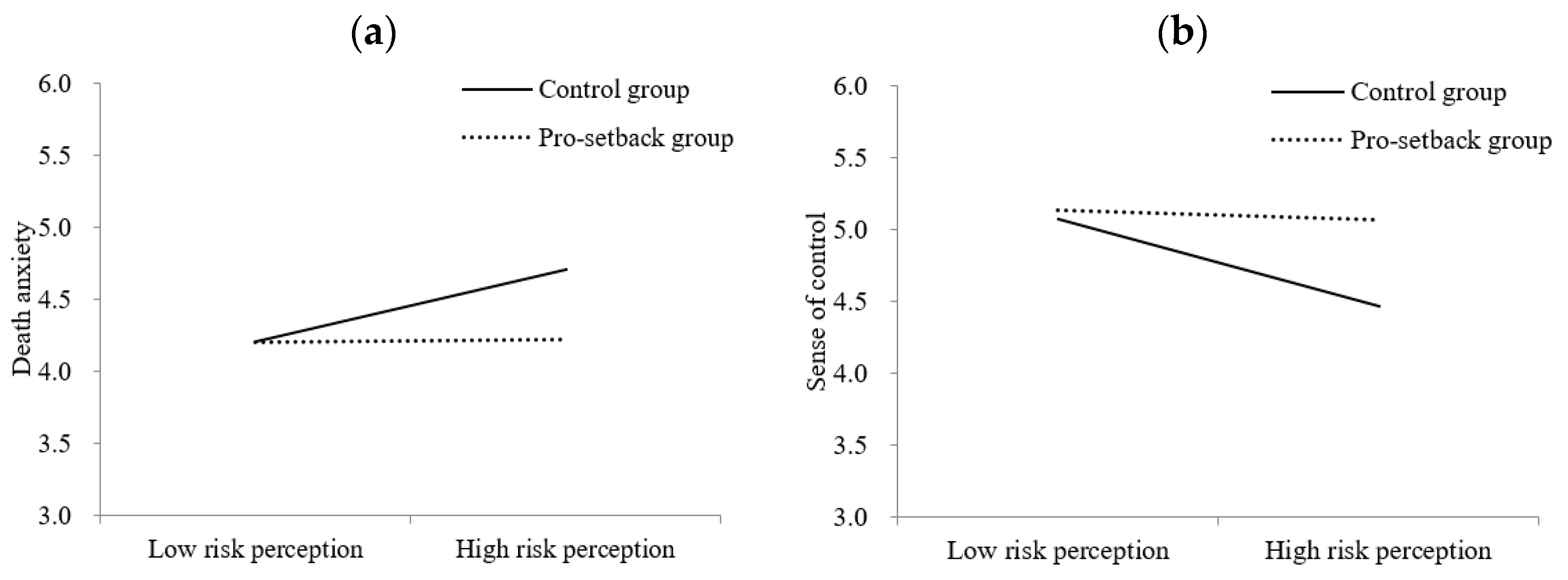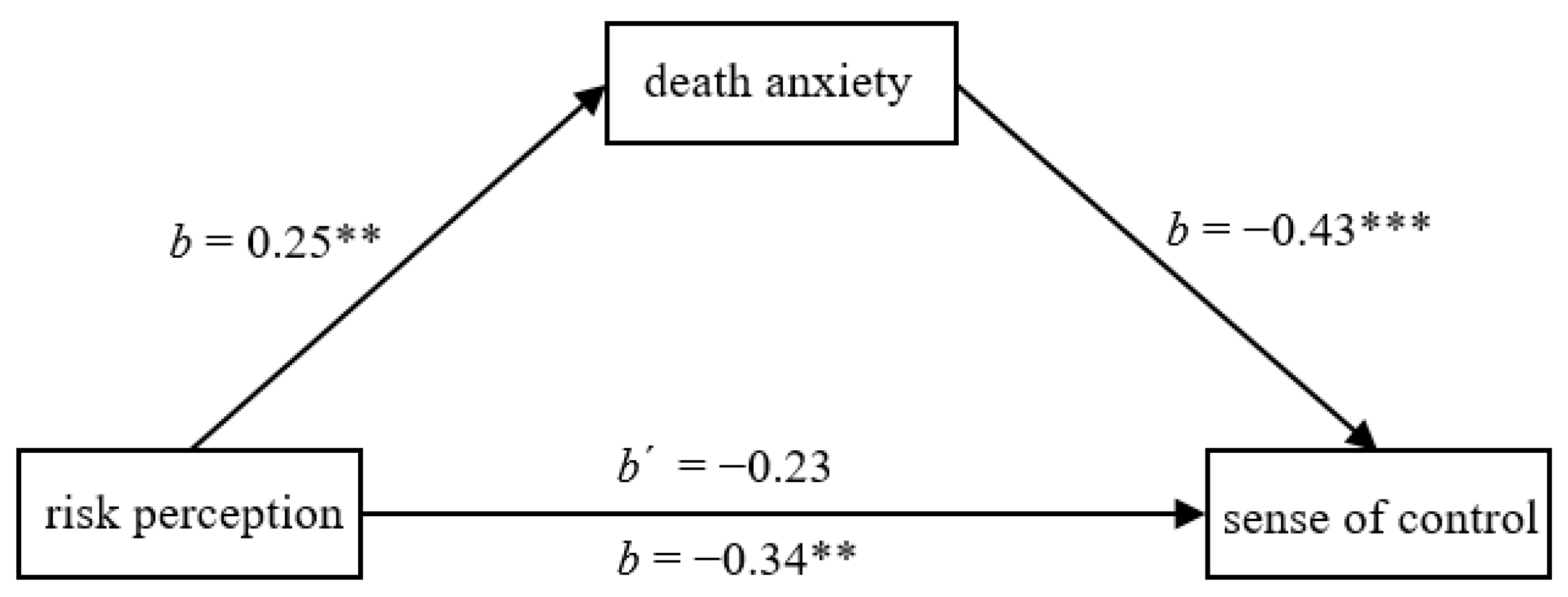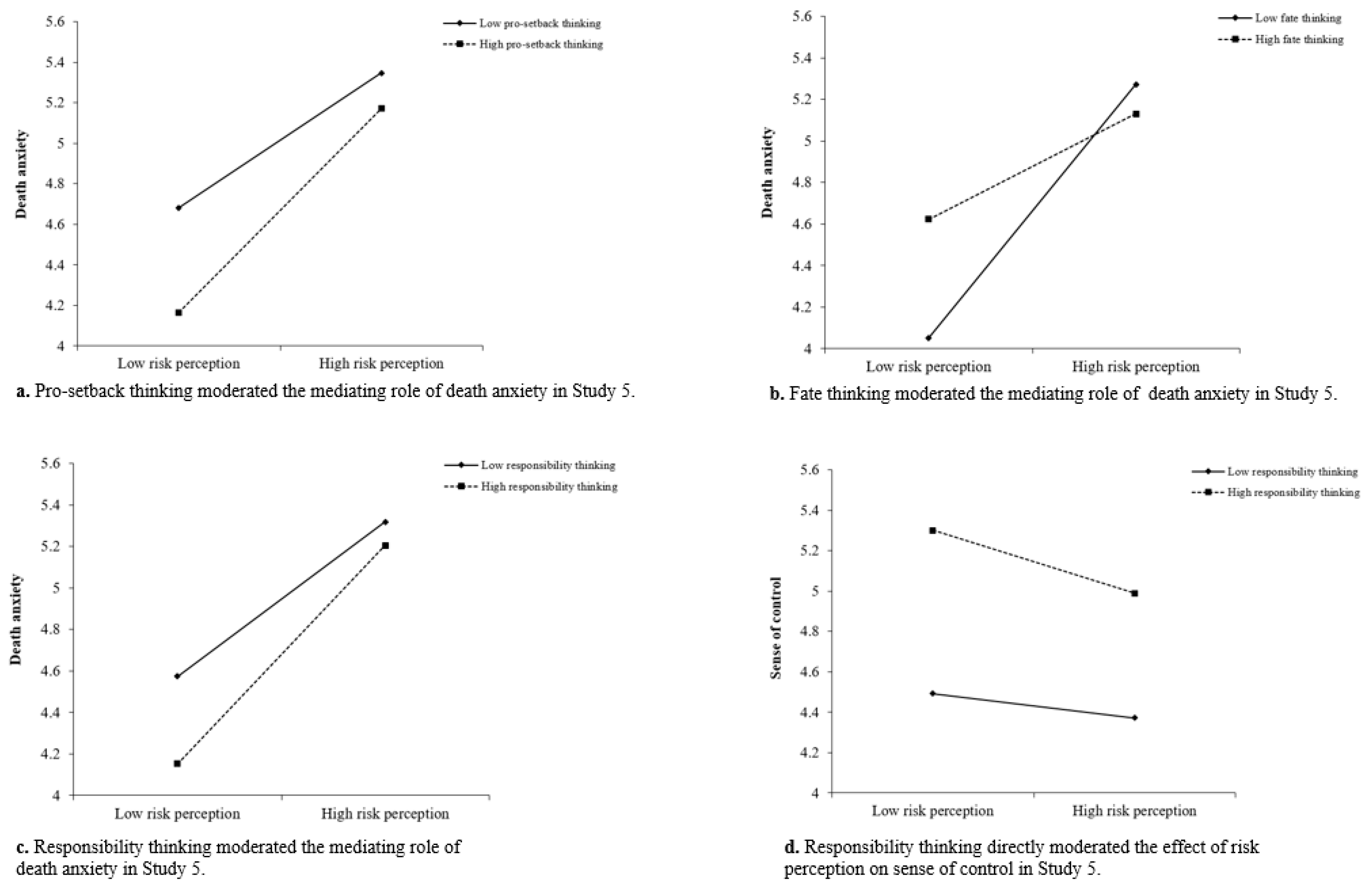How Does COVID-19 Risk Perception Affect Sense of Control? The Roles of Death Anxiety and Confucian Coping
Abstract
1. Introduction
1.1. COVID-19 Risk Perception and Sense of Control
1.2. The Mediating Role of Death Anxiety
1.3. The Moderating Role of Confucian Coping
1.4. The Present Study
1.5. Plan of Analysis
2. Study 1
2.1. Methods
2.1.1. Participants
2.1.2. Procedures and Materials
2.2. Results
3. Study 2
3.1. Methods
3.1.1. Participants
3.1.2. Procedures and Materials
3.2. Results
3.2.1. Manipulation Check
3.2.2. Risk Perception and Sense of Control
4. Study 3a
4.1. Methods
4.1.1. Participants
4.1.2. Procedures and Materials
4.2. Results
4.2.1. Manipulation Check
4.2.2. The Role of Death Anxiety in Risk Perception and Sense of Control
5. Study 3b
5.1. Methods
5.1.1. Participants
5.1.2. Procedures and Materials
5.2. Results
5.2.1. Manipulation Check
5.2.2. Death Anxiety and Sense of Control
6. Study 4
6.1. Methods
6.1.1. Participants and Design
6.1.2. Procedure and Materials
6.2. Results
6.2.1. Manipulation Check
6.2.2. Death Anxiety and Sense of Control
6.2.3. Mediation and Moderated Mediation Analysis
7. Study 5
7.1. Methods
7.1.1. Participants
7.1.2. Procedures and Materials
7.2. Results
7.2.1. Test of Common Method Variance
7.2.2. Mediation Analysis
7.2.3. Moderated Mediation Analysis
8. General Discussion
Supplementary Materials
Author Contributions
Funding
Institutional Review Board Statement
Informed Consent Statement
Data Availability Statement
Conflicts of Interest
References
- Kay, A.C.; Whitson, J.A.; Gaucher, D.; Galinsky, A.D. Compensatory control: Achieving order through the mind, our institutions, and the heavens. Curr. Dir. Psychol. Sci. 2009, 18, 264–268. [Google Scholar] [CrossRef]
- Thompson, S.C.; Sobolew-Shubin, A.; Galbraith, M.E.; Schwankovsky, L.; Cruzen, D. Maintaining perceptions of control: Finding perceived control in low-control circumstances. J. Pers. Soc. Psychol. 1993, 64, 293–304. [Google Scholar] [CrossRef] [PubMed]
- Zhou, X.; He, L.; Yang, Q.; Lao, J.; Baumeister, R.F. Control deprivation and styles of thinking. J. Pers. Soc. Psychol. 2012, 102, 460–478. [Google Scholar] [CrossRef]
- Infurna, F.J.; Gerstorf, D.; Ram, N.; Schupp, J.; Wagner, G.G. Long-term antecedents and outcomes of perceived control. Psychol. Aging 2011, 26, 559–575. [Google Scholar] [CrossRef] [PubMed]
- Ruthig, J.C.; Chipperfield, J.G.; Perry, R.P.; Newall, N.E.; Swift, A. Comparative risk and perceived control: Implications for psychological and physical well-being among older adults. J. Pers. Soc. Psychol. 2007, 147, 345–369. [Google Scholar] [CrossRef]
- Zheng, L.; Miao, M.; Gan, Y. Perceived control buffers the effects of the COVID-19 pandemic on general health and life satisfaction: The mediating role of psychological distance. Appl. Psychol. Health Well-Being 2020, 12, 1095–1114. [Google Scholar] [CrossRef]
- Infurna, F.J.; Gerstorf, D. Perceived control relates to better functional health and lower cardio-metabolic risk: The mediating role of physical activity. Health Psychol. 2014, 33, 85–94. [Google Scholar] [CrossRef]
- Keeton, C.P.; Perry-Jenkins, M.; Sayer, A.G. Sense of control predicts depressive and anxious symptoms across the transition to parenthood. J. Fam. Psychol. 2008, 22, 212. [Google Scholar] [CrossRef]
- Seligman, M.E.P. Learned helplessness. Annu. Rev. Med. 1972, 23, 407–412. [Google Scholar] [CrossRef]
- Soral, W.; Kofta, M.; Bukowski, M. Helplessness experience and intentional (un-)binding: Control deprivation disrupts the implicit sense of agency. J. Exp. Psychol. Gen. 2021, 150, 289–305. [Google Scholar] [CrossRef]
- Gould, S.J. A critique of Heckhausen and Schulz’s (1995) life-span theory of control from a cross-cultural perspective. Psychol. Rev. 1999, 106, 597–604. [Google Scholar] [CrossRef]
- Lachman, M.E. Perceived control over aging-related declines: Adaptive beliefs and behaviors. Curr. Dir. Psychol. Sci. 2006, 15, 282–286. [Google Scholar] [CrossRef]
- Specht, J.; Egloff, B.; Schmukle, S.C. Everything under control? The effects of age, gender, and education on trajectories of perceived control in a nationally representative German sample. Dev. Psychol. 2013, 49, 353–364. [Google Scholar] [CrossRef] [PubMed]
- Paulsen, N.; Callan, V.J.; Grice, T.A.; Rooney, D.; Gallois, C.; Jones, E.; Jimmieson, N.L.; Bordia, P. Job uncertainty and personal control during downsizing: A comparison of survivors and victims. Hum. Relat. 2005, 58, 463–496. [Google Scholar] [CrossRef]
- Nicola, M.; Alsafi, Z.; Sohrabi, C.; Kerwan, A.; Al-Jabir, A.; Iosifidis, C.; Agha, M.; Agha, R. The socio-economic implications of the coronavirus pandemic (COVID-19): A review. Int. J. Surg. 2020, 78, 185–193. [Google Scholar] [CrossRef]
- Goodwin, R.; Wiwattanapantuwong, J.; Tuicomepee, A.; Suttiwan, P.; Watakakosol, R.; Ben-Ezra, M. Anxiety, perceived control and pandemic behavior in Thailand during COVID-19: Results from a national survey. J Psychiatry Res. 2021, 135, 212–217. [Google Scholar] [CrossRef] [PubMed]
- Galea, S.; Merchant, R.M.; Lurie, N. The mental health consequences of COVID-19 and physical distancing: The need for prevention and early intervention. JAMA Intern. Med. 2020, 180, 817–818. [Google Scholar] [CrossRef]
- Mamun, M.A.; Griffiths, M.D. First COVID-19 suicide case in Bangladesh due to fear of COVID-19 and xenophobia: Possible suicide prevention strategies. Asian J. Psychiatr. 2020, 51, 102–173. [Google Scholar] [CrossRef]
- Satici, B.; Gocet-Tekin, E.; Deniz, M.E.; Satici, S.A. Adaptation of the fear of COVID-19 scale: Its association with psychological distress and life satisfaction in turkey. Int. J. Ment. Health Addict. 2020, 19, 1980–1988. [Google Scholar] [CrossRef]
- Reyna, V.F.; Broniatowski, D.A.; Edelson, S.M. Viruses, vaccines, and COVID-19: Explaining and improving risky decision-making. J. Appl. Res. Mem. Cogn. 2021, 10, 491–509. [Google Scholar] [CrossRef]
- Slovic, P. Understanding Perceived Risk: 1978–2015. Environ. Sci. Policy Sustain. Dev. 2016, 58, 25–29. [Google Scholar] [CrossRef]
- Xie, X.F.; Xu, L.C. Overview and theoretical framework of risk perception research. Adv. Psych. 1995, 3, 17–22. [Google Scholar]
- Burns, W.J.; Slovic, P. Risk perception and behaviors: Anticipating and responding to crises. Risk Anal. 2012, 32, 579–582. [Google Scholar] [CrossRef] [PubMed]
- van Baal, S.T.; Walasek, L.; Karanfilovska, D.; Cheng, A.C.; Hohwy, J. Risk perception, illusory superiority and personal responsibility during COVID-19: An experimental study of attitudes to staying home. Br. J. Psychol. 2022, 6, 1–22. [Google Scholar] [CrossRef] [PubMed]
- Savadori, L.; Lauriola, M. Risk perception and protective behaviors during the rise of the COVID-19 outbreak in Italy. Front. Psychol. 2021, 11, 577–598. [Google Scholar] [CrossRef]
- Geng, S.; Zhou, Y.; Zhang, W.; Lou, A.; Cai, Y.; Xie, J.; Sun, J.; Zhou, W.; Liu, W.; Li, X. The influence of risk perception for COVID-19 pandemic on posttraumatic stress disorder in healthcare workers: A survey from four designated hospitals. Clin. Psychol. Psychot. 2021, 28, 1146–1159. [Google Scholar] [CrossRef] [PubMed]
- Han, Q.; Zheng, B.; Agostini, M.; Bélanger, J.J.; Gützkow, B.; Kreienkamp, J.; Reitsema, A.M.; van Breen, J.A.; Collaboration, P.; Leander, N.P.; et al. Associations of risk perception of COVID-19 with emotion and mental health during the pandemic. J. Affect. Disord. 2021, 284, 247–255. [Google Scholar] [CrossRef]
- Xi, J.Z.; She, Z.; Ju, K.; Zhao, J.J.; Hou, X.L.; Peng, Y.N.; Li, Y.; Zuo, Z.H. The Perceived Risk of COVID-19 Pandemic Scale construction and its validity assessment. J. Cap. Norm. Univ. 2020, 4, 131–141. [Google Scholar]
- Gandhi, M.; Rutherford, G.W. Facial masking for COVID-19—potential for “variolation” as we await a vaccine. N. Engl. J. Med. 2020, 383, e101. [Google Scholar] [CrossRef]
- Elemo, A.S.; Ahmed, A.H.; Kara, E.; Zerkeshi, M.K. The fear of COVID-19 and flourishing: Assessing the mediating role of sense of control in international students. Int. J. Ment. Health Addict. 2021, 20, 2408–2418. [Google Scholar] [CrossRef]
- Sohrabi, C.; Alsafi, Z.; O’Neill, N.; Khan, M.; Kerwan, A.; Al-Jabir, A. World health organization declares global emergency: A review of the 2019 novel coronavirus (COVID-19). Int. J. Surg. 2020, 76, 71–76. [Google Scholar] [CrossRef] [PubMed]
- Greenaway, K.H.; Storrs, K.R.; Philipp, M.C.; Louis, W.R.; Hornsey, M.J.; Vohs, K.D. Loss of control stimulates approach motivation. J. Exp. Soc. Psychol. 2015, 56, 235–241. [Google Scholar] [CrossRef]
- Sullivan, D.; Landau, M.J.; Rothschild, Z.K. An existential function of enemyship: Evidence that people attribute influence to personal and political enemies to compensate for threats to control. J. Pers. Soc. Psychol. 2010, 98, 434–449. [Google Scholar] [CrossRef] [PubMed]
- Whitson, J.A.; Galinsky, A.D. Lacking control increases illusory pattern perception. Science 2008, 322, 115–117. [Google Scholar] [CrossRef]
- Nordgren, L.F.; van der Pligt, J.; van Harreveld, F. Unpacking perceived control in risk perception: The mediating role of anticipated regret. J. Behav. Decis. Mak. 2007, 20, 533–544. [Google Scholar] [CrossRef]
- Globig, L.K.; Blain, B.; Sharot, T. Perceptions of personal andpublic risk: Dissociable effects onbehavior andwell-being. J. Risk Uncertain. 2022, 64, 213–234. [Google Scholar] [CrossRef]
- Wnuk, A.; Oleksy, T.; Maison, D. The acceptance of covid-19 tracking technologies: The role of perceived threat, lack of control, and ideological beliefs. PLoS ONE 2020, 15, 238973–238990. [Google Scholar] [CrossRef]
- Miceli, S.; Caci, B.; Roccella, M.; Vetri, L.; Quatrosi, G.; Cardaci, M. Do mental health and vitality mediate the relationship between perceived control over time and fear of COVID-19? A survey in an Italian sample. J. Clin. Med. 2021, 10, 3516. [Google Scholar] [CrossRef]
- Templer, D.I. The construction and validation of a death anxiety scale. J. Gen. Psychol. 1970, 82, 165–177. [Google Scholar] [CrossRef]
- Zhang, X.K.; Guo, J.; Tian, L.M. Can self-esteem buffer death anxiety? The effect of self-esteem on death anxiety caused by mortality salience. Psychol. Sci. 2005, 28, 602–605. [Google Scholar] [CrossRef]
- Karampour, S.; Fereidooni-Moghadam, M.; Zarea, K.; Cheraghian, B. The prevalence of death anxiety among patients with breast cancer. BMJ Support. Palliat. 2018, 8, 61–63. [Google Scholar] [CrossRef] [PubMed]
- Özer, Ö.; Ozkan, Ö.; Özmen, S.; Ercoban, N. Investigation of the effect of COVID-19 perceived risk on death anxiety, satisfaction with life, and psychological well-being. OMEGA-J. Death Dying 2021, 5, 1–19. [Google Scholar] [CrossRef] [PubMed]
- World Health Organization (WHO). WHO Coronavirus Disease (COVID-19) Dashboard. 2022. Available online: https://www.who.int/emergencies/diseases/novel-coronavirus-2019 (accessed on 25 January 2023).
- Roy, D.; Tripathy, S.; Kar, S.K.; Sharma, N.; Verma, S.K.; Kaushal, V. Study of knowledge, attitude, anxiety & perceived mental healthcare need in Indian population during COVID-19 pandemic. Asian J. Psychiatr. 2020, 51, 102083. [Google Scholar] [CrossRef] [PubMed]
- Stojanov, A.; Halberstadt, J.; Bering, J.M.; Kenig, N. Examining a domain-specific link between perceived control and conspiracy beliefs: A brief report in the context of COVID-19. Curr. Psychol. 2021, 8, 1–10. [Google Scholar] [CrossRef] [PubMed]
- Xiong, J.; Lipsitz, O.; Nasri, F.; Lui, L.M.W.; Gill, H.; Phan, L. Impact of COVID-19 pandemic on mental health in the general population: A systematic review. J. Affect. Disord. 2020, 277, 55–64. [Google Scholar] [CrossRef] [PubMed]
- Brophy, N.S.; Seiter, C.R.; Zhao, X. COVID-19 risk perceptions and intentions to engage in familial advance care planning: The mediating role of death anxiety. J. Health Commun. 2021, 26, 684–695. [Google Scholar] [CrossRef] [PubMed]
- Stefan, S.; Fodor, L.A.; Curt, I.; Ionescu, A.; Pantea, N.; Jiboc, N.; Tegzesiu, A.M. Health anxiety, perceived risk and perceived control in following recommended preventive measures during early COVID-19 response in Romania. Br. J. Psychol. 2021, 7, 160–180. [Google Scholar] [CrossRef]
- Kavaklı, M.; Ak, M.; Uğuz, F.; Türkmen, O.O. The mediating role of self-compassion in the relationship between perceived COVID-19 threat and death anxiety. J. Clin. Psychiat. 2020, 23, 15–23. [Google Scholar] [CrossRef]
- Yildirim, M.; Guler, A. Positivity explains how COVID-19 perceived risk increases death distress and reduces happiness. Pers. Ind. Differ. 2021, 168, 110347–110367. [Google Scholar] [CrossRef]
- Fritsche, I.; Jonas, E.; Fankhänel, T. The role of control motivation in mortality salience effects on ingroup support and defense. J. Pers. Soc. Psychol. 2008, 95, 524–541. [Google Scholar] [CrossRef]
- Liu, W.M.; Wang, H.Z.; He, L. When one is dying, will he/she buy domestic products? Exploring whether, why and when the exposure to death-related information will (not) increase domestic brand choices. Acta Psychol. Sin. 2014, 46, 1748–1759. [Google Scholar] [CrossRef]
- Snyder, C.R. Control and the application of Occam’s razor to terror management theory. Psychol. Inq. 1997, 8, 48–49. [Google Scholar] [CrossRef]
- Richter, J. Perspective on Control during the COVID-19 Pandemic; Mental Health Association in New York State, Inc.: Albany, NY, USA, 2020. [Google Scholar]
- Schneider, A.B.; Leonard, B. From anxiety to control: Mask-wearing, perceived marketplace influence, and emotional well-being during the COVID-19 pandemic. J. Consum. Aff. 2021, 6, 1–22. [Google Scholar] [CrossRef] [PubMed]
- Rehman, U.; Shahnawaz, M.G.; Kashyap, D.; Gupta, K.; Kharshiing, K.D.; Khursheed, M.; Khan, N.H.; Uniyal, R. Risk perception, social distancing, and distress during COVID-19 pandemic: Exploring the role of online counseling and perceived social support. Death Stud. 2021, 47, 1–11. [Google Scholar] [CrossRef] [PubMed]
- See, C.M.; Essau, C.A. Coping Strategies in Cross-Cultural Comparison. In Psychologie—Kultur—Gesellschaft; Mayer, B., Kornadt, H.J., Eds.; Springer: Berlin/Heidelberg, Germany, 2010. [Google Scholar] [CrossRef]
- Wang, Q.; Hou, Y.; Koh, J.B.K.; Song, Q.; Yang, Y. Culturally motivated remembering: The moderating role of culture for the relation of episodic memory to well-being. Clin. Psychol. Sci. 2018, 6, 860–871. [Google Scholar] [CrossRef]
- Li, Q.M.; Chen, Y. Intergenerational transmission of Confucian coping and the effect on children’s mental health. J. Southwest Jiaotong Univ. (Soc. Sci.) 2021, 22, 17–24. [Google Scholar]
- Wang, Q. The Autobiographical Self in Time and Culture; Oxford University Press: New York, NY, USA, 2013. [Google Scholar] [CrossRef]
- Yang, Y.; Wang, Q. The relation of emotion knowledge to coping in European American and Chinese immigrant children. J. Child. Fam. Stud. 2016, 25, 452–463. [Google Scholar] [CrossRef]
- Weisz, J.R.; Rothbaum, F.M.; Blackburn, T.C. Standing out and standing in: The psychology of control in America and Japan. Am. Psychol. 1984, 39, 955–969. [Google Scholar] [CrossRef]
- Yen, C. It is our destiny to die: The effects of mortality salience and culture-priming on fatalism and karma belief. Int. J. Psychol. 2013, 48, 818–828. [Google Scholar] [CrossRef]
- Au, E.W.M.; Chiu, C.; Zhang, Z.; Mallorie, L.; Chaturvedi, A.; Viswanathan, M.; Savani, K. Negotiable fate: Social ecological foundation and psychological functions. J. Cross Cult. Psychol. 2012, 43, 931–942. [Google Scholar] [CrossRef]
- Li, T.R.; Hou, Y.B. Psychological structure and psychometric validity of the Confucian coping. J. Educ. Sci. Hunan Norm. 2012, 11, 11–18. [Google Scholar] [CrossRef]
- Zhou, L.H.; Chen, G.; Jiang, Y.H.; Liu, L.Q.; Chen, J. Self-compassion and Confucian coping as a predictor of depression and anxiety in impoverished Chinese undergraduates. Psychol. Rep. 2017, 120, 627–638. [Google Scholar] [CrossRef]
- Schönbrodt, F.D.; Perugini, M. At what sample size do correlations stabilize? J. Res. Pers. 2013, 47, 609–612. [Google Scholar] [CrossRef]
- Cui, X.Q.; Hao, Y.H.; Tang, S.Y.; Fan, K.S.; Tang, Y.R.; Ning, N.; Gao, L.J. Reliability and validity of a self-designed COVID-19 Risk Perception Scale: A large online empirical study. Chin. J. Pub. Health 2021, 37, 1086–1089. [Google Scholar]
- Shapiro, D.H., Jr.; Potkin, S.G.; Jin, Y.; Brown, B.; Carreon, D.; Wu, J. Measuring the psychological construct of control: Discriminant, divergent, and incremental validity of the Shapiro Control Inventory and Rotter’s and Wallstons’ Locus of Control Scales. Int. J. Psychosom. 1993, 40, 35–46. [Google Scholar]
- Faul, F.; Erdfelder, E.; Lang, A.; Buchner, A. G*Power 3: A flexible statistical power analysis program for the social, behavioral, and biomedical sciences. Behav. Res. Methods 2007, 39, 175–191. [Google Scholar] [CrossRef]
- Jiang, T.; Sedikides, C. Awe motivates authentic-self pursuit via self-transcendence: Implications for prosociality. J. Pers. Soc. Psychol. 2021. [Google Scholar] [CrossRef]
- Lachman, M.E.; Weaver, S.L. The sense of control as a moderator of social class differences in health and well-being. J. Pers. Soc. Psychol. 1998, 74, 763–773. [Google Scholar] [CrossRef]
- Schoemann, A.M.; Boulton, A.J.; Short, S.D. Determining power and sample size for simple and complex mediation models. Soc. Psychol. Pers. Sci. 2017, 8, 379–386. [Google Scholar] [CrossRef]
- Pirlott, A.G.; MacKinnon, D.P. Design approaches to experimental mediation. J. Exp. Soc. Psychol. 2016, 66, 29–38. [Google Scholar] [CrossRef]
- He, H.F.; Yan, N.X. The effect of mortality salience on attention: An example of cultural cues. Chin. J. Psychol. 2016, 58, 263–291. [Google Scholar] [CrossRef]
- Greenberg, J.; Pyszczynski, T.; Solomon, S.; Simon, L.; Breus, M. Role of consciousness and accessibility of death-related thoughts in mortality salience effects. J. Pers. Soc. Psychol. 1994, 67, 627–637. [Google Scholar] [CrossRef]
- Watson, D.; Clark, L.A.; Tellegen, A. Development and validation of brief measures of positive and negative affect: The PANAS scales. J. Pers. Soc. Psychol. 1988, 54, 1063–1070. [Google Scholar] [CrossRef]
- Guo, M.Z.; Gan, Y.Q. Reliability and validity of the Chinese version of Positive and Negative Affect Scale-Expanded in 660 college students. Chin. Mental Health J. 2010, 24, 524–528. [Google Scholar] [CrossRef]
- Hayes, A.F. Introduction to Mediation, Moderation, and Conditional Process Analysis: A Regression-Based Approach, 2nd ed.; Guilford Press: New York, NY, USA, 2018. [Google Scholar]
- Podsakoff, P.M.; MacKenzie, S.B.; Podsakoff, N.P. Sources of method bias in social science research and recommendations on how to control it. Annu. Rev. Psychol. 2012, 63, 539–569. [Google Scholar] [CrossRef]
- Podsakoff, P.M.; MacKenzie, S.B.; Lee, J.; Podsakoff, N.P. Common method biases in behavioral research: A critical review of the literature and recommended remedies. J. Appl. Psychol. 2003, 88, 879–903. [Google Scholar] [CrossRef]
- Peluso, A.M.; Pichierri, M. Effects of socio-demographics, sense of control, and uncertainty avoidability on post-COVID-19 vacation intention. Curr. Issues Tour. 2021, 24, 2755–2767. [Google Scholar] [CrossRef]
- Brailovskaia, J.; Margraf, J. The relationship between burden caused by coronavirus (COVID-19), addictive social media use, sense of control and anxiety. Comput. Hum. Behav. 2021, 119, 106720. [Google Scholar] [CrossRef]
- Wang, Q. Why should we all be cultural psychologists? Lessons from the study of social cognition. Perspect. Psychol. Sci. 2016, 11, 583–596. [Google Scholar] [CrossRef]
- Henrich, J.; Heine, S.J.; Norenzayan, A. The weirdest people in the world? Behav. Brain Sci. 2010, 33, 61–135. [Google Scholar] [CrossRef]






Disclaimer/Publisher’s Note: The statements, opinions and data contained in all publications are solely those of the individual author(s) and contributor(s) and not of MDPI and/or the editor(s). MDPI and/or the editor(s) disclaim responsibility for any injury to people or property resulting from any ideas, methods, instructions or products referred to in the content. |
© 2023 by the authors. Licensee MDPI, Basel, Switzerland. This article is an open access article distributed under the terms and conditions of the Creative Commons Attribution (CC BY) license (https://creativecommons.org/licenses/by/4.0/).
Share and Cite
Huang, L.; Hou, Y.; Sun, Z.; Wang, Q. How Does COVID-19 Risk Perception Affect Sense of Control? The Roles of Death Anxiety and Confucian Coping. Int. J. Environ. Res. Public Health 2023, 20, 2299. https://doi.org/10.3390/ijerph20032299
Huang L, Hou Y, Sun Z, Wang Q. How Does COVID-19 Risk Perception Affect Sense of Control? The Roles of Death Anxiety and Confucian Coping. International Journal of Environmental Research and Public Health. 2023; 20(3):2299. https://doi.org/10.3390/ijerph20032299
Chicago/Turabian StyleHuang, Lianqiong, Yubo Hou, Zhaoyang Sun, and Qi Wang. 2023. "How Does COVID-19 Risk Perception Affect Sense of Control? The Roles of Death Anxiety and Confucian Coping" International Journal of Environmental Research and Public Health 20, no. 3: 2299. https://doi.org/10.3390/ijerph20032299
APA StyleHuang, L., Hou, Y., Sun, Z., & Wang, Q. (2023). How Does COVID-19 Risk Perception Affect Sense of Control? The Roles of Death Anxiety and Confucian Coping. International Journal of Environmental Research and Public Health, 20(3), 2299. https://doi.org/10.3390/ijerph20032299






